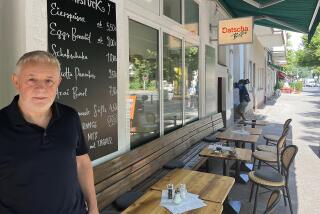Best of Berlin for Young Travelers
- Share via
When the Berlin Wall fell in early November, 1989, Berlin’s east and west sections were rejoined to create the third-largest city in Europe, with a population of about 3.4 million.
It’s a city whose history attracts curious travelers, but it’s also a city struggling with tremendous changes. To make visits easier for independent budget travelers, there’s a free 160-page booklet called “Berlin for Young People.”
Due to its decades of division, Berlin has two of almost everything. There are two zoos, two main opera houses, two clusters of major museums, two commercial centers and two theater districts. There are also three international airports and five railway stations.
The unified Berlin actually has more museums than either London or Paris.
The city also boasts KaDeWe, Europe’s largest department store; a zoological garden (Zoologischer Garten) with one of the largest zoos in the world, housing 11,000 animals of nearly 1,600 species, plus a three-story aquarium, and one of the most abundant botanic gardens (Botanischer Garten) in Europe.
“Berlin for Young People” is designed to help travelers quickly find their way around the city, while getting more than just a superficial impression. It covers transportation options, budget accommodation suggestions, do-it-yourself tours, sightseeing attractions, entertainment, dining, shopping, open-air markets and emergency services.
This publication is designed to help travelers enjoy the city without paying prime prices. For example, the guide advises that many major theaters will sell reduced-price tickets to students with identification one-half hour before show time (assuming tickets are still available).
The guide provides maps and route suggestions for tours by foot or by public bus, ranging from one to five hours. You’ll even find suggestions on which buildings offer good panoramic views. For example, Television Tower, a focal point of the former East Berlin, has a viewing platform and cafe near the 600-foot level.
Some suggested sights include Checkpoint Charlie, where there’s a permanent exhibit on the Berlin Wall; Charlottenburg Palace, the former residence of the Prussian royalty, which now houses a number of museums; Kurfurstendamm, the city’s main boulevard that is lined with cafes, boutiques and prestigious stores, and the Brandenburg Gate, which today is a symbol of German unity.
The booklet does carry this warning: “Colorful and exciting though Berlin night life may be, it does no harm to be a little watchful in the nocturnal jungle of the big city. Along with the many creative aspects, there are also the darker sides of a metropolis: the drug scene and violence. It’s better simply to avoid areas, pubs, clubs and other places where you don’t feel quite at ease.”
When you’re ready to leave Berlin, the guide lists Mitfahrzentralen, or ride centers, that can help arrange transportation to other cities in cars driven by private citizens. It’s a form of car-pooling that links passengers with drivers. You share fuel costs with the driver and pay a fee. It’s cheaper than traveling by bus, and gives visitors a chance to get to know residents.
For copies of “Berlin for Young People” (available in English or French), inquire at Berlin Tourist Information offices. You can find them at the Europa Center (ground floor, entrance on Budapester Strasse); at the Alexanderplatz TV Tower and at the Bahnhof Zoo Railway Station. All offices are open daily.
For other helpful publications and general information on travel to Germany, contact the German National Tourist Office, 11766 Wilshire Blvd., Suite 750, Los Angeles 90025; telephone (310) 575-9799.
More to Read
Sign up for The Wild
We’ll help you find the best places to hike, bike and run, as well as the perfect silent spots for meditation and yoga.
You may occasionally receive promotional content from the Los Angeles Times.






